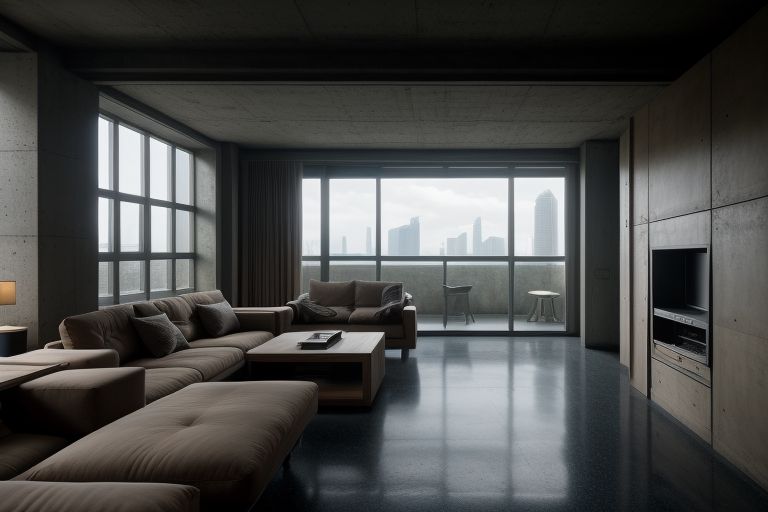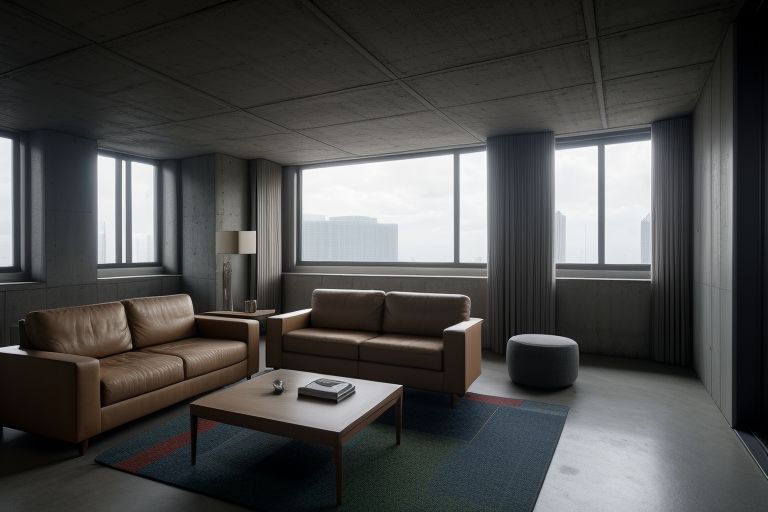The world of interior design frequently follows softer, darker colors and silk textures. Brutalist interior design, on the other hand, is a distinctive response to that; it is a radical and uncompromising one. This architectural style, which was unveiled in the middle of the 20th century, embodies in its manifesto the creative use of raw materials and geometric simplicity that extract the sincerity of forms and materials.

It is the raw aesthetic of this sort of design that makes brutalist interior design a style bold enough to disregard the excessive or complete, and it reinstates the beauty of concrete, steel, and glass. Earlier, these elements were considered raw and brutal, but they are now changing perception as their inherent qualities are glorified so that they can shine in their light in residential and commercial zones alike.
Brutalist interior design.
However, the brutalist interior design was born in a loss of historical context in the same name architectural trend of brutalism, which became especially popular in the 1950s and 1960s. For instance, Frank Lloyd Wright and Le Corbusier used building materials, including concrete, in the most natural conditions and without any unnecessary ornamentation, thus drawing attention to the function, structure, and construction of their buildings.
The moral principle of honesty and simplicity was eventually implanted into the interiors, which led to the rise of an artistic approximation that entitled the crudeness of materials and the masterly combination of the geometric shapes, which were created through the architectural brutalism of the nineties.
Key Elements Brutalist interior design
Concrete:
Concrete is the best-known element, which means it is admired for its textured surface, unfinished face, and naturally imperfect state. From the variety of raw concrete in walls, floors, and furniture to the aestheticized brutalist sculptures, this material is the main part and object of attraction in brutalism spaces.
Raw and Unfinished Surfaces:
First of all, the indiscriminate use of raw materials is an important fact of brutalist interior design. Incomplete exteriors typical of exposed brick, raw wood, and rusted metal contrast with the feeling that one is in a veritable environment whose character is non-artificial, giving a sense of reality and authenticity.
Bold Geometric Forms:
Brutalist architecture is primarily distinguished by its large and rough external surfaces and its design of large, pill-like shapes. And all this is framed by smooth lines. The effect is achieved by using furniture and architectural blocks with sharp corners and distinctively angular features, reflecting the theme of solidity and durability.
Minimalism:
Brutalist architecture besides assaulting with shoddiness and lack of compromise at times, also encourages minimalism. The space is kept clean. The treasures of designs can be highlighted; there would be no place for the chaos.
Lighting and Shadows:
The mise-en-scene and the interaction of shadows and light have become inextricable parts at the core of brutalist interior designers’ work. The tricky part is not to flood the space generously with lights, but to see to it that the show focuses on the spatial forms and texture.
Integrating Brutalist Interior Design
A skillful blend of using the raw and creating the livable and functional while also being sensitive to executing brutalist interior design is a necessary step. Brutalism can be part of the décor through a thoughtful complement of distinct items like a concrete coffee table or a stylish light fixture with sharp forms.
A world of brutalist design is the style for those of us who appreciate deeper, more immersive, and even transformative experiences. These can be recreated anywhere, from rooms to whole houses scouted through this brutal lens. Bare concrete walls and polished concrete floors are good additions, but in the brutalist space, there is no decoration, and the furniture carefully selected as freestanding furnishings is sufficient to create an impactful and authentic brutalist environment.

Softening the Edge
Constructivist or brutalist interior design views an exclusive intellect as a virtue. This approach, however harsh and even cold, The flip side of industrial design is that it can come across as cold, impersonal, and less inviting. To combat this, designers usually include items that soften the environment, like soft lighting, textured fabrics, and natural components such as plants or wooden interfaces.
Such a delicate balance between the rough and the softer does indeed make up the contrast and depth, stimulating the space to feel like it’s not too cold or tight.
A harsh-mode style of interior design for residential spaces.
The so-called brutalist interior design might apply to corporate or industrial spaces alone, while it could also be used to create residential environments. Using warm textures and natural light combined with clever pops of color makes blondism in the house interesting and domestic.
Utilizing such a design wall in the living room as a focal point for a minimalist in an exposed brick and steel accented kitchen is just an example of how brutalist principles can be adopted to create one-of-a-kind living spaces.
Commercial and hospitality applications
The patio or terrace is a great spot to relax, and because of the natural light and greenery, it usually looks brighter and gives a feeling of fresh air. Sometimes each space captures the character of brick, which gives us the feeling of solidity and permanence. Brutalism also participates in the appearance of the space, which is radical and memorable.
It can be brutalism as a design feature in a restaurant, but as an element, it can create different unique and immersive dining areas of modern design with exposed concrete walls, dramatic lighting, and minimalist furniture.
Following design ideas:
- Minimalist Furniture with Angular Forms: Lewarajut slope-liberated a brutalist design embraces the angular-clean type of furniture, which is built with a concrete coffee table or a sofa with steel framing.
- Industrial Lighting Fixtures: Try to get light fixtures that are as decorative as materials such as steel, brass, or concrete and set as the motions.
- Rustic Wood Accents: While proto-brutalism can feature the tough and industrial, the adjacent taste of wood can add warmth and compensate for the composition of the space.
- Indoor Greenery: Infuse the bare, industrial brick interior of the brutalist design with a splash of nature by adding some indoor plants, which would then return to the raw in balance with the organic.
Conclusions about Brutalist interior design
It is not surprising that Brutalist interior design is by no means the cup of tea for a person who is timid and weak, and the clear versatility of this style is rather an acquired taste. It weighs in with full force for a fearless and wholehearted expression of the real, the unprocessed, and the remorselessly truthful. While some may not be warm to the attempt, others willing to engage in the non-traditional aesthetic reap the benefits extensively. That was all about Brutalist interior design.

FAQs about Brutalist interior design
Don’t innovative modernist aesthetics seem to be too drastic and unwelcoming for a dwelling place?
Though brutalism is based on practical aspects and the employment of rugged industrial materials, the designs can be made much more human-friendly and comfortable through the use of warmth as a color scheme, textiles, plants, and wood accessories. The essential thing is ensuring that the purity and sharpness of these elements are not being melted.
As I want to blend brutalist elements, but at the same time I need to ensure that the space does not feel too cold or austere, how do I do this?
Add your wooden elements, plush textiles, and colorful hues in the right places to give your room a visually engaging atmosphere and inviting warmth. Moreover, while trying to have plenty of daylight, look for ways to form snug little corners in the general brutalist space.
Brilliant rather than interiors: do they need technical support?
Concrete and other industrial materials may hold their colors for a long time, even without sealing. However, they might require fresh cleaning now and then. Allocating money to proper materials and detailed sealing makes maintenance less labor-intensive.
Men have the option to choose, uh, bold and aggressive colors, but how can this harsh type of style not look masculine and overbearing?
The rounded edges, the texture renderer, and light color encoding can be used to balance sharp angles and raw materials. Second, apply open formats with a lot of daylight to create a feeling of space.
Which of the typical mistakes connected to brutalist interior design is more problematic?
Don’t use too many unfinished raw materials all around the shop so it won’t seem like a construction site rather than an indoor living space. On the one hand, make sure you place light in proper places because a monotonous glow produced by a flashlight can be depressing.
Does the brutalist approach achieve the best results in compact areas in the residential sector, mainly in apartments or condos?
No doubt, it’s necessary to choose the right balance of interior and not overdo it. Rather than using the whole space for the style, use a few critical and innovative pieces or a section to follow the theme instead of the entire space.
How should I join a brutalist design school with the existing architectural elements, although I know that it is going to be difficult and expensive to use modern interventions?
The criteria for selecting particular materials is to opt for highlighting existing materials using such means as revealing the structure or omission of covering. Secondly, key areas or focal points should be identified, and the rest of the overhaul should be structured around them.

